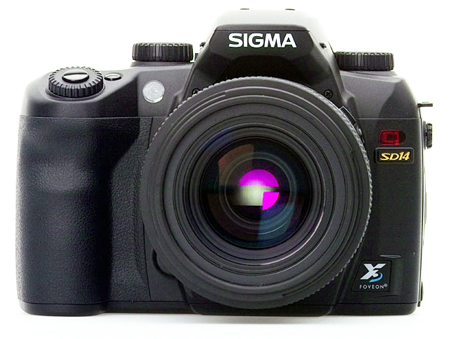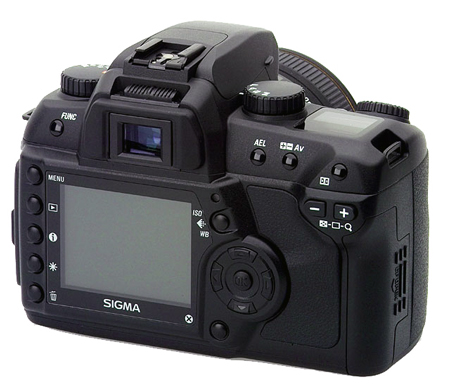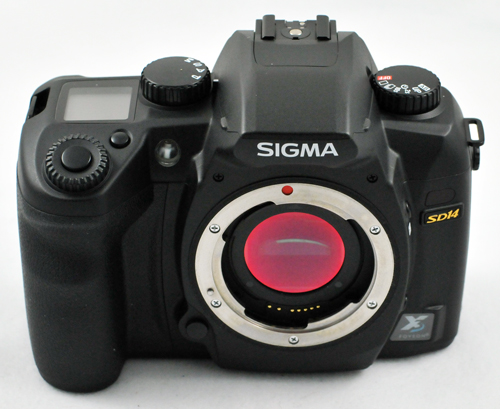Sigma SD14: Quick Look at a Quirky Wonder
by Wesley Fink on June 3, 2008 4:20 AM EST- Posted in
- Digital Camera
Evolution of the SD14
It
is impossible to talk about the specifications, controls, and features of the SD14
without comparing it to the cameras that came before it - the Sigma SD9 and SD10.
Sigma has really refined the SD14. The area that stands out most in the new design is the viewfinder.
The SD9 and SD10 used the old Sigma 35mm viewfinder with dotted lines to show the
new view of the 1.7x sensor. It was almost laughable that their marketing referred to this as some
special form of sports finder where you could see what was outside the frame and
moving into it. The SD9 and SD10 were so slow no one would ever
even consider using them for action photography, so it was all too clear that Sigma
was just recycling an existing 35mm viewfinder.

Interestingly enough the SD14 viewfinder is quite decent. It is a pentaprism (not a pentamirror) and reasonably bright, with 98% horizontal and vertical coverage. This is better coverage than the 95% of the 40D for example, but the Canon 40D has a better .95x magnification compared to the .9x of the SD14. However, compared to the earlier SD10 magnification of .77x the new SD14 viewfinder is dramatically improved. Sigma also claims the viewfinder is high eyepoint, which makes it easier for eyeglass wearers to use. The eyepoint spec is 18mm, which is the same as the Nikon D3.

This is also the first Sigma SD with five AF points. The earlier SD9 and SD10 had a single-point AF module that looks about the same as the 15-year old SA300N. The five focus points are spread widely across the frame, which significantly increases the AF frame coverage on the SD14.

There is also an easy-to-adjust diopter correction on the top of the viewfinder, a real depth-of-field preview button on the left side of the lens mount, and the first built-in pop-up flash in the Sigma SD series. These are nothing special at the original selling price of $1699, but with Cameta and Amazon recently selling the SD14 body for less than $600 they are really standout features at the new price point.
There are also updates that are not so obvious in the SD14, such as USB 2.0 instead of 1.1 and a dramatically improved shutter with a rated life of 100,000 actuations. The new shutter tops out at 1/4000 instead of 1/6000 like the SD10, but a year in the field is proving the new shutter doesn't disintegrate and shred small pieces in the sensor chamber. This was a complaint some had with the SD10. The new shutter is also very quiet - much quieter than the earlier models - and frankly one of the quietest shutters we have found in any camera in its class. That is a welcomed improvement.
This is also the first Sigma SD to use a rechargeable Lithium battery. The earlier models used AA batteries or the CR-V3 variant. Thankfully the new battery is an easy-to-find and reasonably priced NP-400, a battery that is also used in the Minolta 7D/5D, and the Pentax K20D/K200D/K10D. Pentax calls their battery the D-Li-50, Sigma calls it the BP-21, and Minolta called the battery the NP400. Whatever they call it, all three batteries are interchangeable, which makes it easy to find reasonably priced replacement batteries.
Our early experience with battery life was extremely poor. This also appears to be related to the early CF compatibility issues we experienced. After charging to a different brand of CF card that worked better on the SD14 we fired off about 300 shots before depleting the battery. Battery life is better than we first thought, but it is not in the same league with Canon and Nikon CMOS sensors. It is probably a good idea to carry a spare battery or two if you plan a lot of shooting. Note that some users claim battery life does improve after the battery is "conditioned" in the Sigma charger.

As seen on previous SD cameras, Sigma mounts a sensor protector just behind the lens mount to keep dust away from the sensor. The reddish-pink filter inside the lens mount is also the Infrared filter. This makes the SD14 uniquely suited for digital IR photography since the filter is easy to remove without any special tools. The SD14 without this filter is sensitive to both IR and visible light, and by using an IR filter you can make the SD14 sensitive to IR only. The word among IR enthusiasts is that there is nothing better on the market for IR photography than the SD14, and that option is there if you choose.

Sigma uses the Sigma SD all-electronic lens mount, and can only natively mount Sigma lenses. Many photographers do not realize the Sigma mount is all-electronic like the Canon mount, and it has been in existence for more than 15 years. Here you see a very new 18-200mm OS (Optical Stabilized) Sigma lens mount beside a 15+ year old Sigma 50mm Macro lens. The 50mm Macro works perfectly on the new SD14. In fact, the Macro was used for most of the sample images at the end of this review.
Lenses for the SD14 are only available from Sigma, but the current Sigma lens catalog shows 39 lenses available in Sigma SD mount, and there are additional lenses that were made in Sigma mount that have been discontinued over the years. The lens multiplier is 1.7x, just slightly more than the Canon 1.6x, which means the equivalent 35mm focal length is the focal length times 1.7x. That means a 50mm normal lens behaves like an 85mm portrait lens on the SD14.
It is a little more work to find Sigma mount lenses for sale, but Amazon, Cameta, and B&H usually have a decent variety. Sigma also makes their most interesting new lenses, such as the new 18-200mm f3.5-6.3 OS available in Sigma mount. That lens on the Sigma, as with the Nikon 18-200mm VR, is quite a match. It provides a 35mm equivalent of 31-340mm in a single lens with up to four stops of added speed thanks to the new Sigma dual-motor OS.
You can also find Sigma-mount lenses for sale on eBay, sometimes at bargain prices. The Sigma-mount 35mm lenses will fit the new SD14 and they are often very cheap if you are trying to build a quality system on a shoestring.










40 Comments
View All Comments
chibimike - Tuesday, June 3, 2008 - link
Layer-per-primary is not the future.It is a great idea, but passing through the first two layers to get to the red layer eats too much of the light. To make up for it, they make the red layer supersensitive, which then leads to clipping or extremely complex attempts at color correction. Unless there is some breakthrough material to make the sensor out of, it will always be noisy.
aeternitas - Tuesday, June 3, 2008 - link
I see your point, and its a good one.Except useing this method of three layer technology and pretending thats the only way is pretty close minded and short sighted.
Their are better methods than what Foveon has, but layer-per-primary as a base WILL be the future of digital photography. Its a technology in its infancy, and hinestly, do you see any other method that would even come close to haveing the same future potential? If you mention fuji ill shoot you.
Justin Case - Wednesday, June 4, 2008 - link
Potential is irrelevant when the current technology has aready hit the "lens wall".Bayer pattern sensors are already at the limit of lens resolution, and can still be pushed forward. Unless Foveon can suddenly increase the resolution of their sensors by 300%, fix all the color problems, and Sigma releases lenses that can beat the top Nikon and Canon models, they simply don't offer any advantage (note that there are sharper lenses than Canon's or Nikon's - Leica, Hasselblad, Voigtlander, Zeiss - but they're used by less than 0.1% of people).
If anyone is interested in improving the quality of Bayer sensors, the way to go is tetrachromacy (Sony is experimenting with that), but that makes processing more complex and offers only a very slight little advantage, so I don't see that happening, either.
Current Bayer sensors have hit the resolution limit for lenses, and improvements to sensitivity and chroma range are more important than resolution. Since those are precisely the points where Foveon is further behind, its future isn't particularly bright. Some people will continue to buy them, because the concept "seems to make sense", but in the real world they're simply worse in every sense. Even if done "perfectly" (with materials that don't even exist yet), they'd be more expensive and the advantage wouldn't be noticeable without a major upgrade to lens quality.
chibimike - Wednesday, June 4, 2008 - link
No not fuji, great for pocket cams, not so hot for SLRs.I think one of two things. Either a new material with much lower noise properties. Or if costs keep going down, we could potentially see someone do a creative take on the three sensor design like they do in high end video cameras.
aeternitas - Tuesday, June 3, 2008 - link
PS.There is this new and great technology called PNG. No one expects you to display tiff or raw files. I'm not sure why a paragraph was put into explaining that to everyone.
Wesley Fink - Tuesday, June 3, 2008 - link
We use PNG all the time in our articles and reviews and it is a desirable lossless format like TIFF. However it is not really very suitable for photographic images. To quote from Wikipedia:"JPEG can produce a smaller file than PNG for photographic (and photo-like) images, since JPEG uses a lossy encoding method specifically designed for photographic image data. Using PNG instead of a high-quality JPEG for such images would result in a large increase in filesize (often 5–10 times) with negligible gain in quality."
For photographs PNG is no better than JPEG, but the files are MUCH larger. PNG is best with tables and line drawings. We need a new web format as neither TIFF or PNG are suitable and current JPEG is just 8-bit - perhaps an update of JPEG.
Justin Case - Wednesday, June 4, 2008 - link
PNG uses prediction and error coding, followed by entropy encoding. It's pretty much the best lossless algorithm you can get for photos.For line drawings and tables, GIF (LZ compression) will frequently produce smaller files than PNG, especially if they have regular dithering patterns.
If you think there's no difference between JPEG (even at the maximum quality allowed by Photoshop) and PNG, you need to have your eyes checked. Even though Wikipedia is hardly an authoritative source, the article you quoted says "a negligible gain in quality". Not "no gain". You're the one who extrapolated that to "PNG is no better than JPEG".
The meaning of "negligible" depends on the situation. Yes, the PNG files are significantly bigger. And yes, if you use a crappy camera, you'll get artifacts from the lens and sensor anyway. But when you're comparing high-end cameras and sensors, it definitely pays to use a lossless format (generated from raw, of course, not from an in-camera JPEG). Even better, post a couple of raw files and let people who are interested download and compare them using appropriate software.
BTW, there already is an "update of JPEG". It's called JPEG-2000 and gets about 40% higher compression for the same (lossy) image quality, and even supports lossless compression. If you can convince browser makers (namely Microsoft) to add support for it to their software, we'd be thankful. Until then, I doubt it'll catch on.
I have no idea why you need a higher-than-8-bit format "for the web", considering that about half the LCDs out there are actually 6-bit panels and that 99.9% of graphics cards are limited to 8-bpc. We definitely don't need browsers to become more bloated just so they can handle HDR or RPF images natively (which 99% of people have no use for in web pages).
For distribution and webpage "decoration", 8-bit JPEGs are fine. The question is whether they're fine for an article comparing minute differences between high-end digital sensors. And the answer to that is almost certainly no (just as MP3 files aren't really the right choice to evaluate high-end audio equipment).
Deadtrees - Thursday, June 5, 2008 - link
Last time I checked, JPEG2000 is pretty much dead and MS is trying to setup a new JPEG2000 like picture file system along with many other major companies. I forgot the details but it was open architecture and it was better than JPEG 2000.Justin Case - Friday, June 6, 2008 - link
JPEG-2000 is only "dead" due to lack of native support in Windows and web browsers. It's a significant improvement on JPEG.Microsoft's format (which has gone through three names, I think the current one is "MS HD Photo") is a DRM'd format which, in terms of quality vs. compression, is slightly inferior to JPEG-2000 and can only be manipulated through Microsoft's own APIs (very much not an "open architecture"). It does have support for several useful features (like floating-point HDR) but I really don't see those being relevant for a distribution format; if you want HDR data, you probably don't want lossy compression, and vice-versa.
A unified "raw" format for all camera manufacturers, on the other hand, would be nice, but considering the different sensor layouts, different bit depths, different processing required, etc., you would have a single file extension but effectively N different sub-formats.
aeternitas - Tuesday, June 3, 2008 - link
I understand the differance between the two.In context, when mentioning all those formats, and not mentioning png, its kinda off. Also, PNG with such tiny crops is negligible.
Aside from that, a contrustive suggestion would be, if youre going to do side by side images, have a single croped image, and several mouse-overable links that change the image dynamicaly. It gives a much much better result when trying to see subtile differences between cameras.
IMO that would one-up anandtech camera reviews compaired tomost online.